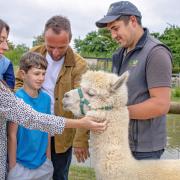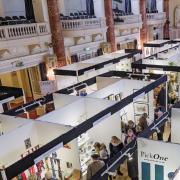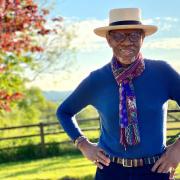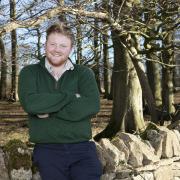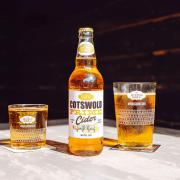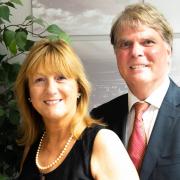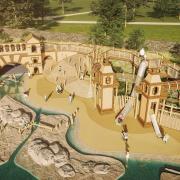Dr Tom Shannon, co-founder of the Oxford Metrics Group and a director of motion capture tech company Vicon Motion Systems, talks about his passion to improve lives and how Hollywood helps

How can just one company dazzle cinema audiences with special effects, turn international rockers Coldplay into computer generated apes, and help improve the lives of children with muscular dystrophy and cerebral palsy?
Through applying clever motion capture technology. This is what Vicon, part of The Oxford Metrics Group based at the city’s Minns Business Park, has been doing for over 32 years.
Motion capture is the technical process of recording movement (of humans, or in fact anything) and using that information to create digital images. The Vicon system is designed to analyse human motion by tracking retro-reflective markers attached to the body. These images can be used in life sciences to better understand how the body works, and in Hollywood to create amazing computer-generated imagery producing startlingly realistic effects used in box office blockbusters such as Titanic, Star Wars and even Paddington Bear.
For Tom Shannon, co-founder of Vicon’s parent company, The Oxford Metrics Group, and a director of Vicon, the Hollywood stuff is very cool, but what really motivates him is what the company does for human good.
“Thousands of children suffer conditions such as cerebral palsy and many can only walk with reduced efficiency,” he explains. “Their quality of life can be improved because equipment like ours and others exists.
“When such children reach a certain point in their lives, because their gait is not efficient, the amount of energy they need to walk is more than they have available, so they’ll have to sit down for longer or become wheel-chair bound. What we produce helps inter-disciplinary clinical teams across the world analyse an individual’s gait to assist in treatment decision making with the goal to improve its efficiency. We help the patient stay active for longer.”

Among other sectors, the company is also helping the world of sport, enabling athletes to enhance their performance.
It’s about synergy, says Tom. “What we learn from one market, we’ll feed into another market. We are a life sciences and engineering business and what floats our boat is medicine and engineering. Winning awards, and these include an Emmy® and even a Guinness World Record certificate through technical wizardry, is fantastic, but fundamentally we are a solid tech business.
“Our technology has to be real world, fast, clever, intuitive and it has to work every time. Advances made in Hollywood can be folded back into improving what we offer in medicine. On the flip side our understanding of human motion in medicine has an immediate application in the movie industry by generating animated characters with even more subtle motion.”
The Oxford Metrics Group (OMG, probably the coolest acronym for an exciting business and almost onomatopoeic in describing what the company does), was born out of Oxford Instruments in 1984.
That year, aged 32 and with a Masters in Physics under his belt, Tom arrived at the company courtesy of a scholarship from Australia to focus on measuring spinal deformity in children, and to learn more about British industry.
“Soon after I arrived, Oxford Instruments decided that motion capture wasn’t for them. They had been selling and installing Vicon systems internationally since 1980, with the first suppled to the University of West Virginia to study the gait of sheep and the second to the Boston Children’s Hospital.” Oxford Instrument’s future lay in exploiting other business opportunities.

Looking at the numbers, Oxford Dynamics (the business’s name at the time) had potential. Tom explains: “Our products were selling into the worldwide motion capture market related to life sciences. While that was mainly into the US, it was clear that there were bigger opportunities.”
Dr Julian Morris, managing director of Oxford Dynamics, decided to seize the opportunity. “Julian gathered together with some founding employees, including me, and we bought the business,” says Tom. Not all of them had the capital to invest so Sir Martin Wood, founder of Oxford Instruments, lent some of them the money, including Tom, on the understanding that it would be paid back within a year. It was, with ease.
Helping children walk better
“At first we concentrated on the life sciences sector, focusing on clinical gait analysis: the measurement of how a child walks including if they were diagnosed with cerebral palsy or Duchenne muscular dystroph,” Tom explains.
Vicon entered the film industry through a lucky connection. Dr Morris, now deputy chairman of OMG, had a son Ben, studying mechanical engineering. “Ben was working as an intern for the film company making Mary Riley, starring Julia Roberts,” says Tom. “They were looking for a realistic way for Mr Hyde to emerge from Dr Jekyll and had no idea how to do it. Ben suggested his dad’s company. Our next film was Titanic.” Ben has gone on to win awards in his own right, including an Oscar®, for his special effects work on Golden Compass.
OMG became so successful that it was winning Queen’s Awards and by 2001 it had became a public company, growing through organic expansion and acquisition.
In 2006 the company set up Yotta, to provide highway authorities with complete visual records of their road networks. Potholes, manhole covers, cracks in the road and street furniture such as stop signs can be identified using Yotta’s advanced computer vision-based surveying techniques. Three-dimensional reconstructions are provided as an online service to local councils so they can repair more quickly (helping to avoid costly court actions from disgruntled motorists and pedestrians).
More purchases followed including, in 2013, the acquisition of Stonehouse-based Mayrise Services Ltd, to accelerate the growth of Yotta. Mayrise offers asset management solutions including street works, street lighting, waste management and grounds maintenance complementing Yotta’s services.
OMG is now a £25 million turnover business consisting of Vicon, Yotta and OMG Life. It nurtures and grows great technology to realise value. The company employs around 230 hugely talented people at sites in Oxford, Leamington Spa, Gloucestershire and overseas (Denver, Los Angeles, USA and Singapore). It sells as well as buys, of course. Most recently selling 2d3 (a company it established in 2000) to Boeing for $25 million. 2d3 operated in the defence sector, specialising in motion imagery processing of critical intelligence, surveillance and reconnaissance data.
Tom occupies a unique position within the company. “I oversee risk, information security and management systems of the companies. However, 60% of my time is dedicated to looking at new worlds, new opportunities and ideas, and I get to play with cool stuff.”
OMG has links to lots of different universities, and some ideas come from there. Students and lecturers contact the company because they have a great idea and they don’t how to get it made and marketed. OMG can help them realise their ideas.
Tom is also a visiting professor at Staffordshire University, and he’s particularly interested in how to make medicine affordable. He’s currently working on how to identify changes in the backs of children diagnosed with adolescent idiopathic scoliosis more quickly, using three dimensional reconstruction.
“We want to be able to produce the equipment to enable a rapid method of assessment. We’re looking at a retail cost of £300, infinitely affordable for doctors, and we will give the software away for free. It’s early days, but we’re hopeful.”
The best sort of scientist
Tom might have more qualifications than I’ve had hot dinners, (including a PhD in Computer Vision which he completed only six years ago), but he’s easy to talk to –enthusiastic but rooted in and with a broad perspective of the real world gleaned from his training and how his professional career has panned out.
As well as his obvious enthusiasm for his job (I’ll never retire says this 64-year-old), he and his family own a sheep and cattle farm in Somerset, though he lives with his wife in Shipton under Wychwood. He also has a passion for history, and having served as a regular soldier in the Australian services and also a former Major in Oxfordshire’s Territorial infantry Regiment, he became a Trustee Director of the Soldiers of Oxfordshire Museum at Woodstock.
As he shows me some videos of Vicon projects, I spot a photograph on his desk of an English gentleman with a man who looks suspiciously like Mahatma Gandhi. It is. “My great-grandfather was the governor in Bombay at a time when Gandhi was very active,” he says. “They were sparring partners but also great friends and when Gandhi came to the All India Conference in 1932 he stayed with my great-grand parents at Boars Hill, Oxford. I have the picture on my desk as a daily reminder that friendship can overcome all obstacles.”




